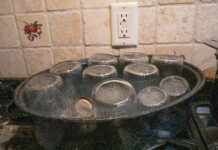LINCOLN, Neb. – There’s no doubt about it: Odors from livestock operations can stink.
But research shows odors are not uniformly distributed, and University of Nebraska-Lincoln engineers are developing tools that will help producers and communities better plan for them.
Weather conditions in northeastern Nebraska are likely to disperse the strongest odors to the north and northwest of a livestock facility, while conditions in southeastern Nebraska are likely to result in stronger odors to the north and south of a facility, said Rick Stowell, a university animal environmental engineer.
Local level. Stowell and others in the university’s Institute of Agriculture and Natural Resources are using research into odor emission and dispersion to develop resources that assess where livestock odors will cause the most problems, which can help create buffer zones of varying sizes and shapes around livestock operations.
“What we want to do is make available resources that help these communities better assess those situations at the local level,” Stowell said.
“Eventually these resources will allow communities to make better-informed decisions.”
Such tools as odor roses, directional setback distance curves and odor footprints are being produced for six regions in Nebraska, said Stowell, who is working on this research with other biological systems engineers.
These resources, the result of computer modeling and other research, are known collectively as the Odor Footprint Tool.
Help. The tool’s resources will help livestock producers plan new or expanded livestock facilities to reduce odor impact and help county zoning officials evaluate proposed construction of livestock facilities.
“All in all, these tools will give sound, scientific information for communities when it comes to applying county zoning laws and assessing the expected impact on neighbors downwind of the sources of the smells,” Stowell said.
The odor footprints reveal areas expected to be affected by livestock odors more often than the locally selected standard with an aerial view format, he said.
“You might want to think of this like a contour map,” Stowell said.
“Instead of showing different elevations, they basically show a two-dimensional map outlining frequencies of annoying odor levels.”
The odor footprint for an operation is specific to conditions at the time it’s developed.
If a producer changes something about his proposed operation, such as the herd size or use of proven odor control, a new footprint should be developed, Stowell said.
Setback. This is where directional setback distances and odor roses help.
The directional setback distances simplify the process of making routine assessments and evaluating options by considering the maximum separation distance in each of four main directions around the site.
Using these separation distances, “pie slices” of varying distance to the edge can be drawn, Stowell said.
This is done to the north, south, east and west of the site, or to the northeast, southeast, northwest and southwest of the site, giving a good idea of the expected reach of odor impact in each direction, Stowell said.
“It is a simpler approach, requiring no additional modeling,” Stowell said.
“Like most simplified tools, it is also more conservative, showing a slightly larger area of odor impact.”
Future plans include getting the setback distances in a spreadsheet format.
Currently it is a paper form with calculations to fill out.
Focusing. The odor rose focuses on weather factors, such as prevailing wind direction and strength, that will determine the directions of greatest odor impact.
“The odor rose will tell you the percentage of time that annoying odor levels will be sustained in a certain direction. It’s called a rose because each compass direction is assigned a petal,” Stowell said.
“The length of the petal indicates the likelihood of odor impact in that direction. An odor rose is basically one-size fits all for an area – it is not affected by the type or size of operation.”
What’s the weather? Odor impact also depends on what type of day it is, Stowell said.
“Whether it’s windy, blustery, humid or sunny, it all has an effect on odor,” he said.
“The calmer and more stable it is, the more odors will remain concentrated near the ground and become an annoyance for more-distant neighbors.”
Hot, humid days and calm nights generally produce the worst odor conditions, Stowell said.
When it is windy, it’s like a mixing bowl and the odors are diluted.
Already. “This research is already producing benefits. We are seeing a lot of educational benefits from this research and some early planning with communities and livestock producers,” Stowell said.
“By giving people these visuals, it shows them the impacts of what they are planning on air quality for their neighbors.”
Researchers also are in the middle of validation, or field tests.
Last summer several people from Lincoln, mainly students, received “odor sniffer” training and made weekly visits to a Nebraska livestock operation.
After doing a little on-site searching for where odor was moving, called “plume chasing,” they took standardized readings at different distances from the site.
The measurements they took with their noses are being compared to the model’s projections.
The team is getting ready to train neighbors of a livestock operation to take readings, and by the end of summer should have data needed to validate the process.
Get 4 Weeks of Farm and Dairy Home Delivered









